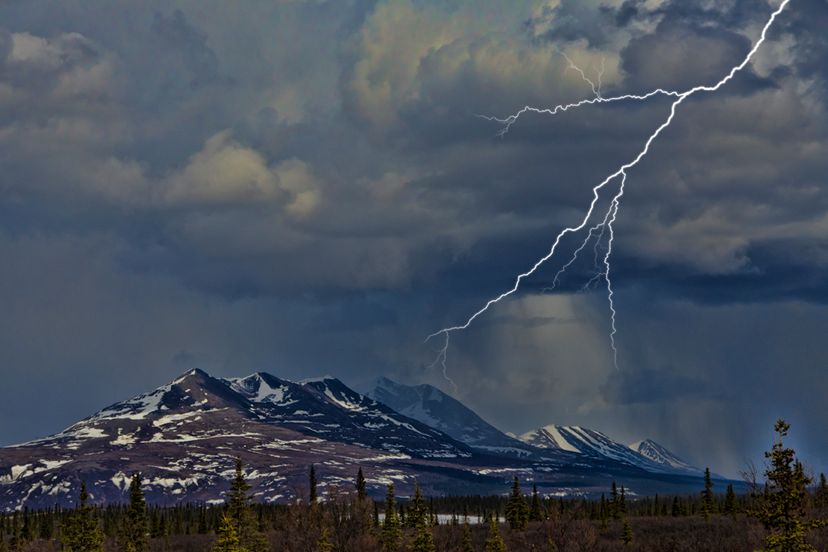

It would be nice to know without a doubt when snow was coming. But as schoolchildren can tell you, what they really need is a way to make snow appear. On a school night. Before that stupid report is due. All these old wives’ tales about predicting snow are fine and good, but what kids really need is a way to guarantee a snow day.
Instead, we’re stuck with pretty vague — or perhaps suspiciously too specific — tales of when we might be able to enjoy a good blanketing. Consider the old adage that thunder in the winter brings snow within seven days. It’s pretty on the nose for weather lore. Come to think of it, it’s a little too pointed for any weather prediction. When was the last time you heard a forecaster guarantee a big weather activity a week out? As they say about these things — you can’t really accurately predict them.
But that doesn’t mean there isn’t actually a little grain of truth in the phrase. Winter thunder does tell us a bit more about how the weather might behave than, say, a groundhog that sniffs its way out of a burrow once a year. Thunder, on the other hand, does in fact signal a certain type of weather front, which might give us a glimpse of the cold stuff.
The general idea is that thunder develops in atmospheres conducive to — surprise! — thunderstorms. You’re not going to get a ton of the rumbly stuff on, say, a clear day with no chance of rain. However, cold air and low-pressure systems from the north, displacing warm air and high pressure in the south, form an unstable atmosphere that can create terrific conditions for thunderstorms. Now, that means if you’re hearing thunder in the winter, it could signal that a cold front is moving in. A moist weather system making its way through next could conceivably bring snow. A safe prediction you could make after hearing thunder in winter? Some cold weather is on its way.
Naturally, the “seven days” thing is a bit of a stretch. While a cold front could signal some snow, there’s certainly no predicting when (or if) another wet weather system could arrive. What we do know (according to one study) is that if you do get “thundersnow,” you’re likely to get dumped on quite heavily [source: Crowe et al.]. However, the Royal Meteorological Society noted that thundersnows only account for 0.07 percent of snowstorms in the U.S.
Originally Published: Aug 19, 2015
Thunder In Winter FAQ
What does it mean when it thunders in the winter?
There’s an old saying that states, “thunder in the winter brings snow in seven days.” While that’s not entirely accurate, thunder in the winter is an indication of a cold weather front. Though there’s no way to tell exactly how soon it’ll come in, the thunder is likely indicative of a dumping of snow on its way.
Is it normal to have thunderstorms in winter?
Winter thunderstorms, called “thundersnow”, are not a common occurrence, though they do happen occasionally.
How rare is a thundersnow?
Thundersnows are rare enough that The Royal Meteorological Society found that they only account for 0.07 percent of snowstorms in the U.S.
What is ice thunder?
Ice thunder is another name for freezing rain or sleet that falls during a thunderstorm.
Lots More Information
Related Articles
Sources
- Crowe, Christina; Market, Patrick; Pettegrew, Brian; Melick, Chris; and Podzimek, Josef. “An investigation of thundersnow and deep snow accumulation.” Geophysical Research Letters. December 2006. (Dec. 16, 2014) http://onlinelibrary.wiley.com/doi/10.1029/2006GL028214/abstract
- Engelbrecht, Matt. “Matt’s World Of Weather: Thunder in Winter, Snow in 7 Days?” WITN.com. Feb. 19, 2014. (Dec. 16, 2014) http://www.witn.com/home/headlines/Matts_World_Of_Weather_Thunder_in_Winter_Snow_in_7_Days_138963304.html
- Lyttle, Steve. “Want snow? Wear pajamas inside out.” Weather Guy. Jan. 18, 2011. (Dec. 16, 2014) http://obsweatherguy.blogspot.com/2011/01/want-snow-wear-your-pajamas-inside-out.html
- Majoros, Martie. “The facts behind the folklore.” The Old Farmer’s Almanac. 2015. (Dec. 16, 2014) http://www.almanac.com/sites/new.almanac.com/files/074_11ofa_weatherlore.pdf
- Pennsylvania State University. “Winter Thunderstorms.” 2004. (Dec. 16, 2014) https://courseware.e-education.psu.edu/courses/meteo361/Section02p02.html
- StormFax Weather Almanac. “Groundhog Day.” 2014. (Dec. 16, 2014) http://www.stormfax.com/ghogday.htm

0 Comments :
Post a Comment